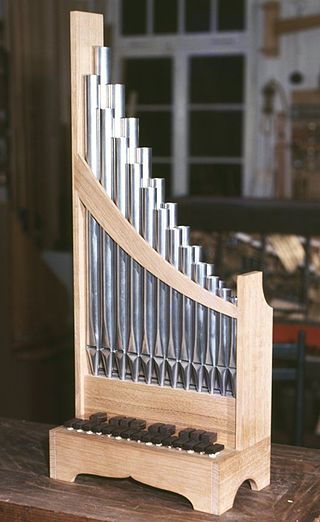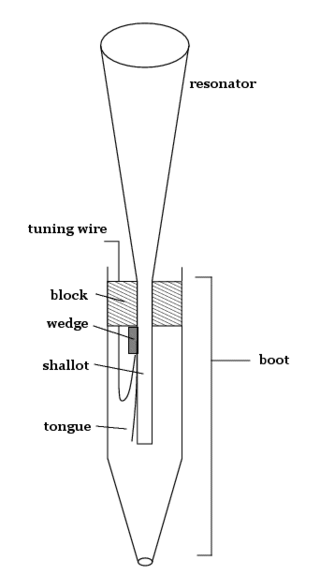
The pipe organ is a musical instrument that produces sound by driving pressurized air through the organ pipes selected from a keyboard. Because each pipe produces a single pitch, the pipes are provided in sets called ranks, each of which has a common timbre and volume throughout the keyboard compass. Most organs have many ranks of pipes of differing timbre, pitch, and volume that the player can employ singly or in combination through the use of controls called stops.
Overblowing is the manipulation of supplied air through a wind instrument that causes the sounded pitch to jump to a higher one without a fingering change or the operation of a slide. Overblowing may involve a change in the air pressure, in the point at which the air is directed, or in the resonance characteristics of the chamber formed by the mouth and throat of the player.

An organ stop is a component of a pipe organ that admits pressurized air to a set of organ pipes. Its name comes from the fact that stops can be used selectively by the organist; each can be "on", or "off".

An electric organ, also known as electronic organ, is an electronic keyboard instrument which was derived from the harmonium, pipe organ and theatre organ. Originally designed to imitate their sound, or orchestral sounds, it has since developed into several types of instruments:

Scaling is the ratio of an organ pipe's diameter to its length. The scaling of a pipe is a major influence on its timbre. Reed pipes are scaled according to different formulas than for flue pipes. In general, the larger the diameter of a given pipe at a given pitch, the fuller and more fundamental the sound becomes.

A pedalboard is a keyboard played with the feet that is usually used to produce the low-pitched bass line of a piece of music. A pedalboard has long, narrow lever-style keys laid out in the same semitone scalar pattern as a manual keyboard, with longer keys for C, D, E, F, G, A and B, and shorter, raised keys for C♯, D♯, F♯, G♯ and A♯. Training in pedal technique is part of standard organ pedagogy in church music and art music.

A flue pipe is an organ pipe that produces sound through the vibration of air molecules, in the same manner as a recorder or a whistle. Air under pressure is driven through a flue and against a sharp lip called a labium, causing the column of air in the pipe to resonate at a frequency determined by the pipe length. Thus, there are no moving parts in a flue pipe. This is in contrast to reed pipes, whose sound is driven by beating reeds, as in a clarinet. Flue pipes are common components of pipe organs.

An organ pipe is a sound-producing element of the pipe organ that resonates at a specific pitch when pressurized air is driven through it. Each pipe is tuned to a specific note of the musical scale. A set of organ pipes of similar timbre comprising the complete scale is known as a rank; one or more ranks constitutes a stop.

The Wanamaker Grand Court Organ, located in Philadelphia, Pennsylvania is the largest fully-functioning pipe organ in the world, based on the number of playing pipes, the number of ranks and its weight. The Wanamaker Organ is located within a spacious 7-story Grand Court at Macy's Center City and is played twice a day Monday through Saturday. The organ is featured at several special concerts held throughout the year, including events featuring the Friends of the Wanamaker Organ Festival Chorus and Brass Ensemble.

A steam whistle is a device used to produce sound in the form of a whistle using live steam, which creates, projects, and amplifies its sound by acting as a vibrating system.
Bourdon, bordun, or bordone normally denotes a stopped flute/flue type of pipe in an organ characterized by a dark tone, strong in fundamental, with a quint transient but relatively little overtone development. Its half-length construction makes it especially well suited to low pitches, and economical as well. The name is derived from the French word for 'bumblebee' or 'buzz'.

A portative organ, also known during Italian Trecento as the organetto, is a small pipe organ that consists of one rank of flue pipes, sometimes arranged in two rows, to be played while strapped to the performer at a right angle. The performer manipulates the bellows with one hand and fingers the keys with the other. The portative organ lacks a reservoir to retain a supply of wind, thus it will only produce sound while the bellows are being operated. The instrument was commonly used in European secular music from the 12th to the 16th centuries.

A flue is a duct, pipe, or opening in a chimney for conveying exhaust gases from a fireplace, furnace, water heater, boiler, or generator to the outdoors. Historically the term flue meant the chimney itself. In the United States, they are also known as vents for boilers and as breeching for water heaters and modern furnaces. They usually operate by buoyancy, also known as the stack effect, or the combustion products may be 'induced' via a blower. As combustion products contain carbon monoxide and other dangerous compounds, proper 'draft', and admission of replacement air is imperative. Building codes, and other standards, regulate their materials, design, and installation.

A reed pipe is an organ pipe that is sounded by a vibrating brass strip known as a reed. Air under pressure is directed towards the reed, which vibrates at a specific pitch. This is in contrast to flue pipes, which contain no moving parts and produce sound solely through the vibration of air molecules. Reed pipes are common components of pipe organs.

The Boardwalk Hall Auditorium Organ is the pipe organ in the Main Auditorium of the Boardwalk Hall in Atlantic City, New Jersey, built by the Midmer-Losh Organ Company. It is the largest organ in the world, as measured by the number of pipes.
Gedackt is the name of a family of stops in pipe organ building. They are one of the most common types of organ flue pipe. The name stems from the Middle High German word gedact, meaning "capped" or "covered".
This article describes the process and techniques involved in the tuning of a pipe organ. Electronic organs typically do not require tuning.
Whenever a wave forms through a medium/object with a closed/open end, there is a chance of error in the formation of the wave, i.e. it may not actually start from the opening of the object but instead before the opening, thus resulting on an error when studying it theoretically. Hence an end correction is sometimes required to appropriately study its properties. The end correction depends on the radius of the object.

A wind instrument is a musical instrument that contains some type of resonator in which a column of air is set into vibration by the player blowing into a mouthpiece set at or near the end of the resonator. The pitch of the vibration is determined by the length of the tube and by manual modifications of the effective length of the vibrating column of air. In the case of some wind instruments, sound is produced by blowing through a reed; others require buzzing into a metal mouthpiece, while yet others require the player to blow into a hole at an edge, which splits the air column and creates the sound.
William E. Haskell was an American organ-builder and inventor born on November 29, 1865 in Chicago, Illinois. His father, Charles S. Haskell, was also an organ-builder employed by the Roosevelt organ company, located in Philadelphia. At the age of 18, Haskell began working with his father, and around 1901, he established the William E. Haskell Co. of Philadelphia, Pennsylvania. This organ-building firm was later acquired by Estey Organ Co., and Haskell became superintendent of the Estey pipe organ division, which was located in Vermont. He died there on May 13, 1927.













